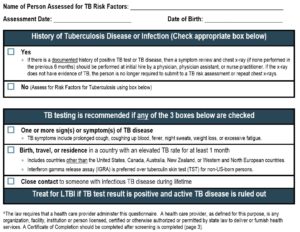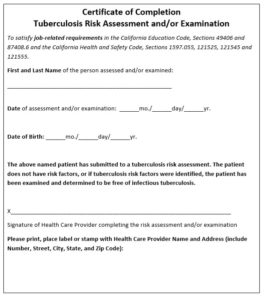The start of the year is very exciting because a new group of students, coworkers, and parent volunteers will be coming together to bring fresh energy into the school and classrooms.
Teachers and staff work closely with volunteers to ensure the success of our many programs. Volunteers will often ask me what requirements they must meet in order to work at the school with many of them asking about the tuberculosis (TB) test. I’ve put together some information on the requirements for TB testing are in the state of California, with a close focus on Los Angeles County.
TB testing requirements in California
Here are three helpful online resources to help you understand the TB testing landscape:
County of Los Angeles Public Health
California Department of Public Health
California Tuberculosis Controllers Association
Some interesting history to consider:
1) Prior to 2012 there was a universal TB testing policy – everyone got tested before coming on campus
2) In 2012, LA County adopted the use of “risk assessment surveys” and a universal screening policy for students (rather than testing) – only students who are identified to be at risk for TB need to be tested
3) Between 2015 to 2017, three new California laws were enacted to adopt a similar risk assessment approach for teachers and volunteers – only those identified to be at risk for TB need to be tested. A certificate of completion of a TB risk assessment for someone found to have no risks can be accepted for clearance for employment or volunteering.
As we all know, there are exceptions to most laws and TB is no exception. There are still specialized education settings that still require universal TB testing by California law. These include employees and volunteers at heritage schools, e.g. part time language/culture schools and pupils for schools of the deaf and blind.
Takeaway #1: If you are a “new” parent volunteer at your local public school and will have “frequent or prolonged contact” with students, you should take a TB risk assessment to determine whether further screening is necessary.
What constitutes “frequent or prolonged contact with students”?
Examples include (but are not limited to) regularly-scheduled classroom volunteering and field trips where cumulative face-to-face time with students exceeds 8 hours.
What is a TB risk assessment?
A TB risk assessment is a series of questions used to determine whether or not you are at risk for TB infection and should be tested. A TB risk assessment is not used for screening people who have documented history of a positive TB test or TB disease.
If you are found to be “at risk” for latent TB infection, LTBI means the M. tuberculosis bacteria is present, but you do not show any signs or symptoms. A good way to think about it is as if the TB is sleeping but could wake up.
The TB risk assessment forms and instructions were designed for use by medical professionals, hence why they can be quite intimidating. At first glance, the assessment instructions and presentation of the information reminded me somewhat of filling out the tax withholding section on a W-4 form for work – ask 3 people how to fill it out and you will get 3 different answers. Also, the TB risk assessments can be slightly different depending on your age, your position and state of residency.
Here is an image of a recent TB risk assessment for California school students, employees and volunteers:

Thankfully, Accesa Labs has created an easier way to take an initial self-assessment which you can find here. You will still need to have a health care provider administer an official TB risk assessment and sign a certificate of completion (see below).

Takeaway #2: If you are a parent volunteer at your local public school in California, a signed Certificate of Completion of the TB risk assessment and/or examination is required.
Who may sign the Certificate of Completion in California?
- If the patient has no TB risk factors then the health care provider completing the TB risk assessment may sign the Certificate of Completion.
- If a TB test is performed and the result is negative, then the licensed health care provider interpreting the TB test may sign the Certificate.
- If a TB test is positive and an examination is performed, only a physician, physician assistant, or nurse practitioner may sign the Certificate.
You can find the Los Angeles County paperwork here which is helpful to bring to your meeting with a health care provider. If you are from another area or state, search for your local TB control program as they should be able to point you in the right direction.
What happens if you need to get tested?
If testing has been deemed necessary there are currently two different types available:
1) The TB skin test, or Mantoux tuberculin skin test (TST)
2) The TB blood test, or Interferon Gamma Release Assay (IGRA).
Why is the TB screening process important?
While the number of cases in the United States is small when compared to other parts of the world, TB still affects many people in the United States and specifically in my home of Los Angeles. According to the California Tuberculosis Controllers Association, in Los Angeles County there were a reported 511 people diagnosed with TB in 2017 and a total of 6,380 cases from 2008-2017. The California Department of Health reported in 2017 there were 2,056 new cases in the state as a whole. California ranks the highest with 5.2 cases per 100,00 individuals. The use of TB risk assessments rather than universal screening is part of the The California Department of Public Health plan to eliminate TB by 2040. We must be diligent in our efforts to comply with screening/assessment requirements to protect those around us.
Hopefully this information eliminates one unknown when it comes to volunteering. Take the TB risk assessment so that you can get one step closer to volunteering – your children will love it!